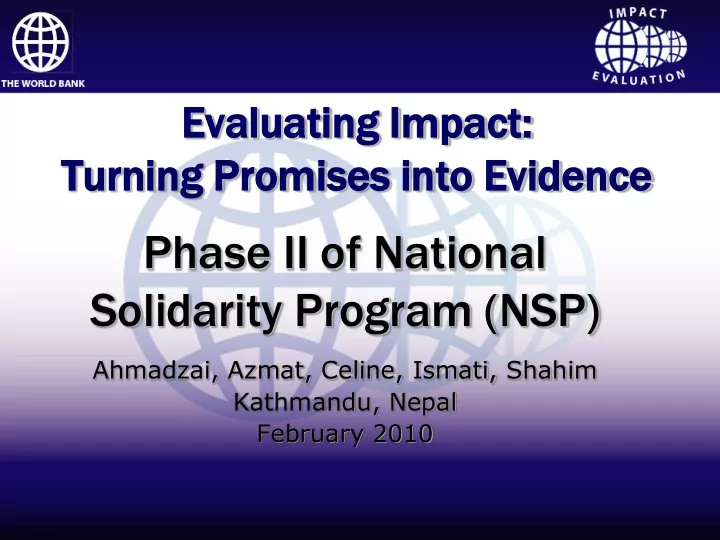

Ev Evaluating aluating Im Impact: act: Tu Turning ning Promises omises in into to Ev Evid idence ence Phase II of National Solidarity Program (NSP) Ahmadzai, Azmat, Celine, Ismati, Shahim Kathmandu, Nepal February 2010
1. Background The National Solidarity Programme (NSP) first began as a component of the Emergency Community Empowerment & Public Works Project in June 2002. It became a full fledged National Priority Programme (NPP) in 2003 under Afghanistan’s National Development Framework Over the last several years has grown to become the government’s flagship programme that is nationally executed. Social Capital – Creation of CDCs, Training, used as the local institution, Physical Capital – CDCs receive block grants, prioritize its projects and implement Financial Capital – CDCs receive fund in their bank account, control over financial resources, contribute minimum 10%, practice collection of fund for immediate needs. Current status : 75% of rural Afghanistan is covered, 29000 villages, 22000 CDCs, $700 Million, provided to CDCs as Block grants since 2003 35000 small scale sub projects are completed and more than 15000 are ongoing, Achieve national coverage, 22000 to 31000 CDCs, 29000 villages to 42000. 2
2. Results Chain Inputs Activities Outputs Outcomes Long term Outcomes • fund • Hire facilitating • CDCs recognized by • CDCs • Human partners • FPs hired community as the recognized resources • Re-elect the CDCs /contracted in 34 legitimate local as village • Material • Revise CDP and provinces of the government council and prioritize sub projects country institution managed • Training of CDC • CDCs re elected • decisions made village members • CDPs revised and Inclusively , budgets • Provision of funds the sub projects are development funds • CDCs • Implementation of sub identified managed in oversee all projects • Fund received by accountable manner the • Link CDCs to INGOs CDCS • CDCs reached by developmenta and government • CDCs trained government and other l funds and authorities • Sub projects development actors interventions • Assist the finalization implemented and • Solidarity and • Increased of sub national completed cohesion economic governance policy • CDCs are used as strengthened within activities (SNGP) entry point for the community development activities 3 • SNGP is finalised
3. Primary Research Questions Who is the most effective and efficient at implementing NSP: -NGOs -NSP staff -MRRD Which approach of monitoring is the most effective and efficient way? -Community Participatory Monitoring (CPM) -Third Party Monitoring 4
4. Outcome Indicators Mobilization: Number of steps followed in operational manual Transparency: Secret ballot election carried out Accountability: Social audit meetings conducted Training: Number of trainings conducted Number of completed sub projects Number of sub projects used by community Sustainability: Number of CDCs functional, Number of sub projects functional 5
5. Identification Strategy/Method Using ex-ante matching method to find three sets of three similar districts each; Randomly allocate implementing agencies within each set of similar districts; Compare performance between implementing agencies using district fixed effects and controlling for village characteristics 6
6. Sample and data Pilot in subset of the country (34 provinces, 359 districts and 25,000 communities) NSP will hire a specialist to compute the power calculation for sample size To be determined number of villages in each district (randomly chosen) Village level data Mix existing evaluation data, monitoring data and ad-hoc surveys 7
7. Time Frame/Work Plan Three years: whole length of project cycle Work plan: two surveys - First survey before starting the implementation of sub projects - End line survey by completion of sub projects and full utilization of block grant 8
8. Sources of Financing NSP budget 9
Recommend
More recommend